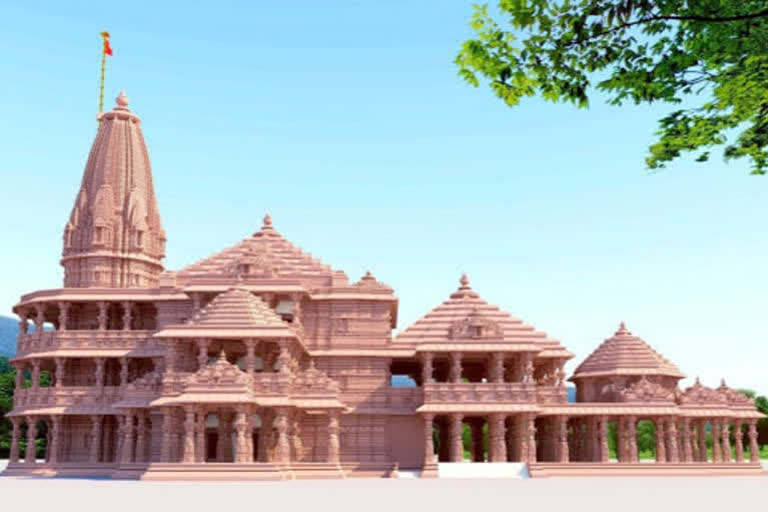Hyderabad:Prime Minister Narendra Modi on Wednesday laid the foundation for the construction of the Ram Temple in the presence of leading luminaries of public life including a phalanx of sadhus and sants from across the country. Modi laid the foundation with a silver brick weighing over 22.6 kg worth Rs 15 lakh.
According to Kameshwar Chaupal, a member of Shri Ram Janmabhoomi Teerth Kshetra, Vishwa Hindu Parishad (VHP) workers and devotees of Lord Rama had been sending water and soil from holy rivers and religious places across the country for the 'bhoomi pujan'. All those devotees, who were not able to come to Ayodhya due to coronavirus, sent holy water and soil. Well-known Hindu spiritual leader and preacher Morari Bapu had announced to donate Rs 5 crore for the construction of the temple.
Here are the states and shrines from where holy water and soil were sent to Ayodhya for the 'bhoomi pujan'.
UTTARAKHAND: WATER AND SOIL FROM HOLY SHRINES
The holy water and soil from the Gangotri, Yamunotri, Badrinath, Kedarnath, and other mutts and temples were sent to Ayodhya. The VHP took up the task of sending water and soil from rivers and temples to Ayodhya. Badrinath Dham priest Ishwari Prasad Namboodari and chief religious head Bhuwan Chandra Uniyal handed over the holy water and soil to the VHP to be taken to Ayodhya. According to them, Lord Vishnu is worshipped at Badrinath and Lord Rama is his incarnation. The Chamoli unit of the VHP had taken up the responsibility to take holy water and soil of Karnprayag, Nandprayag, Vishnuprayag, Badrinath Dham and Alaknanda River to Ayodhya.
BIHAR: SOIL WITH PRAYER OF WORLD PEACE FROM BODH GAYA
From the land of Bihar's Bhojpur region, soil and water was sent to Ayodhya. It is worth mentioning that Bindgama village in Bihar is situated on the confluence of Saryu, Ganga and Sone, which is a rare thing not only in India but in the global ambit of religious belief. This place has a mention in many epics and scriptures. Locals are elated over the fact that they were able to offer the soil and water of the rare confluence to the abode of Lord Ram.
At the same time, the water of holy river Saryu along with the soil of Dharni Baba Madheshwarnath Shri Ram Ghaat of Manjhi had been sent to Ayodhya. Similarly, Buddha Lama of Mahabodhi temple in Bodh Gaya had handed over the holy soil and water to the VHP to be taken to Ayodhya. Before offering the holy soil and water from the Mahabodhi temple, Buddhist monks prayed for world peace amidst the chanting of mantras.
DELHI: SOIL FROM 12 RELIGIOUS PLACES OF NATIONAL CAPITAL
The VHP sent holy soil from 12 religious places located in the national capital. The units of VHP launched a nationwide campaign to collect soil and water from all holy places to be sent for the construction of Ram temple in Ayodhya. The holy soil had also been collected from Shardapeeth in Pakistan occupied Kashmir (PoK). VHP's national working president Alok Kumar sent an urn filled with holy soil to Ayodhya.
In view of the corona pandemic, the programme of laying the foundation stone of Ram temple had been limited to avoid unnecessary crowding. As a result, a large number of Lord Rama devotees and VHP workers were not able to participate in the 'Bhoomi pujan' programme. The VHP is of the view that if there were no corona threat, then lakhs of devotees from all over the country would have gathered in Ayodhya.
Read:Ayodhya Timeline: Here's how the events unfolded
JHARKHAND: HOLY SOIL, WATTER FROM DOMUHANI CONFLUENCE
The holy soil and water from different places of worship including Jharkhand’s Sarna Sthal were sent to Ayodhya. A pot containing five litres of holy water from East Singhbhum district was also sent. The volunteers of VHP and Bajrang Dal took the holy water from the confluence of Swarnarekha and Kharkai rivers at Sonari. It was preceded by the performance of religious rites and rituals by the priests. Similarly, the holy water and soil from religious places in Giridih district were also sent to Ayodhya. The holy soil and water was collected from several religious places including Jamunia, Barakar rivers, Jharkhand Dham, Dukhharan Nath, Surya Mandir, Mirjaganj, Rajdah Dham and Shri Durga Shakti Mandir, Bagodar.
HARYANA: HOLY WATER FROM 101 SHRINES SENT TO AYODHYA
The holy particles from Haryana's important 101 temples and other places of pilgrimage were collected and worshipped before being sent to Ayodhya. At the call of sants, the workers of Vishwa Hindu Parishad collected the holy particles from all major temples and places of worship. Mahamandaleshwar sant Kamta Das of ancient Panchavati temple, belonging to the time of Pandavas, said that these holy particles were to be used in the 'bhoomi pujan'. Not only this, many devotees of Lord Rama also sent holy water and soil from Surajkund.
